
| ||
 In the vast expanses of Eastern Africa, particularly in the borderlands between Ethiopia and Sudan, roams a breed of cattle steeped in tradition and utility – the Abigar cattle. Belonging to the esteemed Sanga cattle breed, these majestic creatures are revered for their dual-purpose nature, serving as prized assets in both dairy and beef production.
In the vast expanses of Eastern Africa, particularly in the borderlands between Ethiopia and Sudan, roams a breed of cattle steeped in tradition and utility – the Abigar cattle. Belonging to the esteemed Sanga cattle breed, these majestic creatures are revered for their dual-purpose nature, serving as prized assets in both dairy and beef production.Bearing witness to centuries of agricultural heritage, Abigar cattle are deeply ingrained in the fabric of Eastern African culture. Their presence on the lush pastures of the region is a testament to their adaptability and resilience in the face of the harsh and varied climates that define their homeland. Primarily raised for dairy purposes, Abigar females stand as paragons ... | ||
 | ||
| ||
 Abondance Cattle is a mixed race breed which originated in
the high valleys of Haute-Savoie, France.
Abondance Cattle is a mixed race breed which originated in
the high valleys of Haute-Savoie, France. They are medium-sized; the females weigh between 580 and 680 kilograms (kg) and stand 1.30 meters tall the bulls weigh between 645 and 820 kilograms (kg). The females are golden brown with a white head, underside of the abdomen, and extremities of its legs; they stand about 1.70 meters tall. The bull’s color is different, with a chestnut red and a bit of white on the head. Abondance Cattle milk is rich in both fat and protein, with a good balance between the two. The milk is traditionally used to produce, Appellation d''Origine Contrôlée (AOC) cheese such as reblochon, Abondance, tome des Bauges, and Bea ... | ||
 | ||
| ||
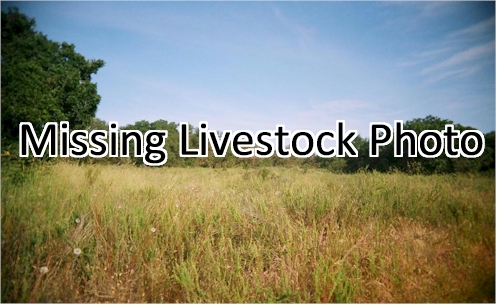 Abyssinian
Shorthorned Zebu cattle are a sub-breed of Zebu Cattle.
Abyssinian
Shorthorned Zebu cattle are a sub-breed of Zebu Cattle. | ||
 | ||
| ||
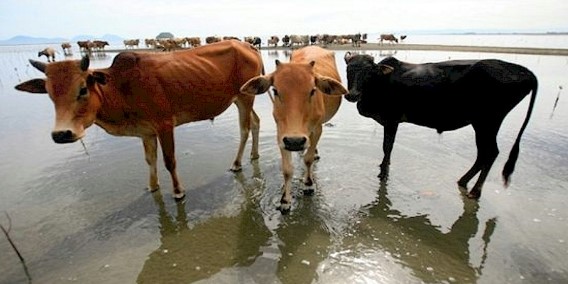 Aceh cattle, also referred to as Acehnese cattle, hail from the Aceh province in northern Sumatra, Indonesia. These bovines stand tall as one of the predominant domestic cattle breeds within Indonesia''s rich livestock heritage.
Aceh cattle, also referred to as Acehnese cattle, hail from the Aceh province in northern Sumatra, Indonesia. These bovines stand tall as one of the predominant domestic cattle breeds within Indonesia''s rich livestock heritage.
These medium-sized creatures boast a robust physique and a compact build, making them well-suited for various agricultural tasks. Their coat colors range from light brown to dark brown, often adorned with distinctive white markings on their heads, legs, and bellies. Sporting short horns that elegantly curve upwards, Aceh cattle possess a gentle and manageable temperament, rendering them easy to handle. Aceh cattle play a crucial role in the agricultural landscape of the region. While primarily ... | ||
 | ||
| ||
 Achham cattle are a unique type of zebu cattle
found in the Achham region of Nepal. They are small; the cows average 88 cm in
height at the withers with an average weight of 110 kg. Bulls average 97 cm at
the withers and weigh on average 150 kg.
Achham cattle are a unique type of zebu cattle
found in the Achham region of Nepal. They are small; the cows average 88 cm in
height at the withers with an average weight of 110 kg. Bulls average 97 cm at
the withers and weigh on average 150 kg.Acham cattle are suitable for hill conditions and are used mainly
for milk production. They vary from black to white, i.e. black, brown, grey,
white, spotted black and white. They are reared by the farmers of the Far
Western Development Region of Nepal, particularly in Achham, Bajhang, Bajura,
and Doti districts.
Content and photo source: Omkar Gaudham
| ||
 | ||
| ||
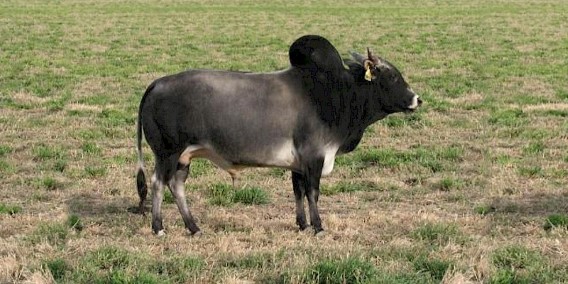 Hailing from Nigeria''s northeastern Adamawa region, Adamawa cattle embody versatility. These medium-sized animals, with their well-proportioned build and typically white coat (reminiscent of White Fulani or Bunaji breeds), play a key role in local agriculture. Their medium-sized, crescent-shaped horns and distinctive pendulous hump set them apart.
Hailing from Nigeria''s northeastern Adamawa region, Adamawa cattle embody versatility. These medium-sized animals, with their well-proportioned build and typically white coat (reminiscent of White Fulani or Bunaji breeds), play a key role in local agriculture. Their medium-sized, crescent-shaped horns and distinctive pendulous hump set them apart.
Valued for both meat and milk production, Adamawa cattle thrive in the region''s hot and dry climate, showcasing both adaptability and resilience. Their reputation for hardiness and disease resistance is well-deserved, while their calm and docile temperament makes them easy to manage. Beyond individual livelihoods, these cattle contribute significantly to communities by prov ... | ||
 | ||
| ||
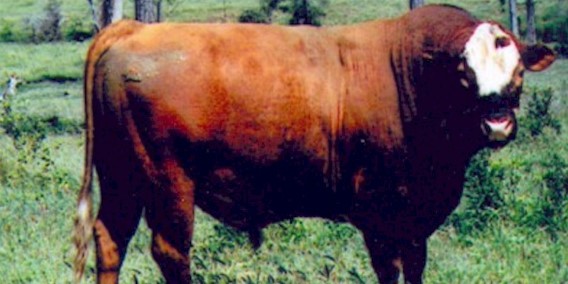
Adaptaur (also known as Belmont Adaptaur or just Adaptaur)
cattle were developed in Australia in the 1950’s from crosses between Hereford
and Shorthorn cattle. They were selected mainly for increased resistance to the
stresses of the tropics, particularly heat, and cattle ticks. Adaptaur bulls
are early maturing and medium size. They are relatively easy to care: sleek
coat, well pigmented eyes and good resistance to heat, ticks and internal
parasites. | ||
 | ||
| ||
 Africangus cattle, also known as South African Angus or Afrigus, are a distinct breed resulting from the crossbreeding of Angus cattle with indigenous African breeds. Originating from South Africa, these cattle combine the renowned traits of Angus cattle with the adaptability and resilience of local African breeds.
Africangus cattle, also known as South African Angus or Afrigus, are a distinct breed resulting from the crossbreeding of Angus cattle with indigenous African breeds. Originating from South Africa, these cattle combine the renowned traits of Angus cattle with the adaptability and resilience of local African breeds.Africangus cattle typically exhibit a medium to large frame, with a sturdy build and well-muscled physique. They possess a glossy black coat, reminiscent of their Angus heritage, which provides them with a striking and distinctive appearance. Additionally, Africangus cattle may display white markings on their face, chest, or extremities, adding to their visual appeal. One of the defining characteristics of A ... | ||
 | ||
| ||
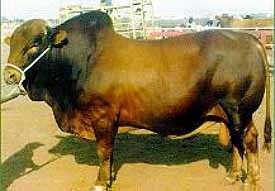 Afrikaner cattle, developed from the native Hottentot cattle of the Cape of Good Hope in South Africa, boast a rich history rooted in the region''s agricultural heritage. These medium-sized cattle are characterized by loose skin and large drooping ears, distinguishing them from other breeds. Bulls of the Afrikaner breed typically exhibit the distinctive Zebu hump, contributing to their robust appearance.
In terms of appearance, Afrikaner cattle showcase a diverse range of colors, spanning from a light tan to a deep cherry red, while their creamy white horns add to their striking visual appeal. Beyond their aesthetic features, Afrikaners are renowned for their practical attributes, making them highly sought after in various agricultural s
...
Afrikaner cattle, developed from the native Hottentot cattle of the Cape of Good Hope in South Africa, boast a rich history rooted in the region''s agricultural heritage. These medium-sized cattle are characterized by loose skin and large drooping ears, distinguishing them from other breeds. Bulls of the Afrikaner breed typically exhibit the distinctive Zebu hump, contributing to their robust appearance.
In terms of appearance, Afrikaner cattle showcase a diverse range of colors, spanning from a light tan to a deep cherry red, while their creamy white horns add to their striking visual appeal. Beyond their aesthetic features, Afrikaners are renowned for their practical attributes, making them highly sought after in various agricultural s
...
| ||
 | ||
| ||

Agerolese cattle come from the province of Naples; today only few hundreds head of cattle are bred in the Agerola, Pagani, Gragnano areas. It is the result of crossbreeding of Holstein, Brown and Jersey with local stock. The breed is at risk of extinction, has suffered a considerable reduction throughout the years because of the frequent replacement crossbreeding with the Italian Holstein. Since 1985 the Registry Office of autochthonous cattle breeds and ethnic groups of limited diffusion has been founded, in order to protect those Italian cattle breeds at risk of extinction and to
| ||
 | ||
| ||
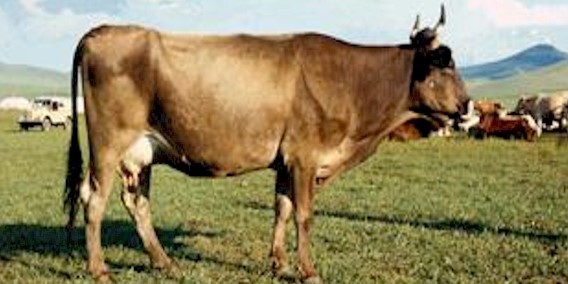 Nestled within the rugged splendor of the Alatau mountain region in Kazakhstan, roams a breed of cattle as majestic as the peaks that cradle them – the Ala Tau, also affectionately known as Alatau cattle. Revered for their dual-purpose nature, these magnificent creatures stand as prized assets in the agricultural landscape of the region, serving as invaluable contributors to both beef and dairy production.
Nestled within the rugged splendor of the Alatau mountain region in Kazakhstan, roams a breed of cattle as majestic as the peaks that cradle them – the Ala Tau, also affectionately known as Alatau cattle. Revered for their dual-purpose nature, these magnificent creatures stand as prized assets in the agricultural landscape of the region, serving as invaluable contributors to both beef and dairy production.With a heritage steeped in the rich tapestry of Kazakh culture, Ala Tau cattle embody the timeless virtues of resilience, adaptability, and utility. Born amidst the breathtaking vistas of the Alatau mountains, these cattle have evolved to thrive in the harsh and varied climates that define their homeland. Valued for ... | ||
 | ||
| ||
 In the heart of the hilly regions of modern-day Tamil Nadu, India, thrives a breed of cattle as rare and resilient as the landscapes they call home – the Alambadi. Born from the storied past of Alambadi Village, these majestic creatures have carved out a niche for themselves in the annals of Indian agriculture, revered for their adaptability and versatility.
In the heart of the hilly regions of modern-day Tamil Nadu, India, thrives a breed of cattle as rare and resilient as the landscapes they call home – the Alambadi. Born from the storied past of Alambadi Village, these majestic creatures have carved out a niche for themselves in the annals of Indian agriculture, revered for their adaptability and versatility.Once primarily kept as drought animals, tasked with enduring the harsh realities of arid climates, Alambadi cattle have evolved over time. Today, local cattle breeders are on a quest to unlock their full potential, striving to enhance their milk production and elevate their status within the agricultural community. Medium-sized and robust, Alambadi cattle cut a str ... | ||
 | ||
| ||
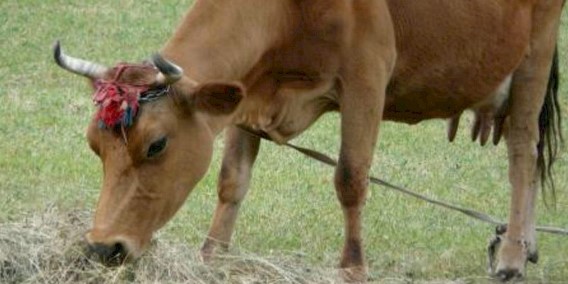 Albanian Cattle are yellow to red-black dual-purpose cattle
from Albania, of course. They are generally used as a draught animal and for
milk production. They are similar to the brachyceros-type cattle breeds in
Yugoslavia and Greece.
Albanian Cattle are yellow to red-black dual-purpose cattle
from Albania, of course. They are generally used as a draught animal and for
milk production. They are similar to the brachyceros-type cattle breeds in
Yugoslavia and Greece.
| ||
 | ||
| ||
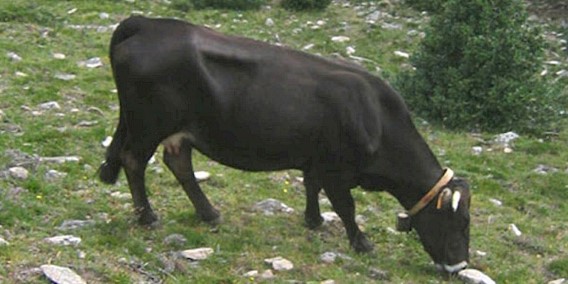 Albera are an endangered breed of small cattle indigenous to
the Albera Massif, which divides Catalonia from France and lies partly in the comarca of Alt Empordà in the Catalan province of Girona, and partly in the comarca of Vallespir in the French département of Pyrénées-Orientales.
Albera are an endangered breed of small cattle indigenous to
the Albera Massif, which divides Catalonia from France and lies partly in the comarca of Alt Empordà in the Catalan province of Girona, and partly in the comarca of Vallespir in the French département of Pyrénées-Orientales.
Although the presence of a cattle breed in the Albera Massif was noted in the nineteenth century, the first description of the Albera dates from 1957. At that time three sub-types were distinguished within the breed: a dark-coated type; a variable paler type; and a third type deriving from cross-breeding with Braunvieh stock. More recently, the types are considered to be tw the Negra, or dark type, and the Fagina, or paler type. In 1999 the F ... | ||
 | ||
| ||
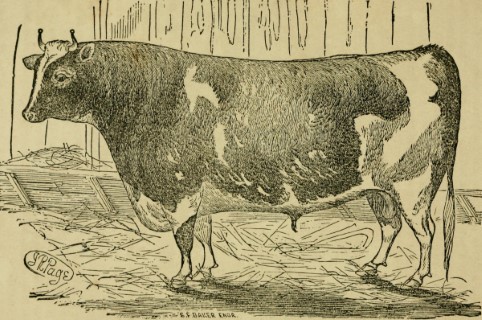 Alderney cattle were a breed of dairy cattle from the
British Channel Island of Alderney; however, they are no longer found on the
island. Pure Alberney cattle are now extinct, though hybrids still exist. Alderney
cattle were one of three Channel Island cattle breeds, the others being the
Jersey and the Guernsey.
Alderney cattle were a breed of dairy cattle from the
British Channel Island of Alderney; however, they are no longer found on the
island. Pure Alberney cattle are now extinct, though hybrids still exist. Alderney
cattle were one of three Channel Island cattle breeds, the others being the
Jersey and the Guernsey.Pure-breed Alderney cattle were smaller, more slender boned animals than the cattle of the other Channel Islands and in some ways they were more deer-like than bovine. They were docile and would even follow children passively back to their pastures. Their milk was copious and produced very rich butter. A 1912 writer said, "The Alderney ranks as the best butter cow in the world, whilst its abundant yield of milk ... | ||
 | ||
| ||
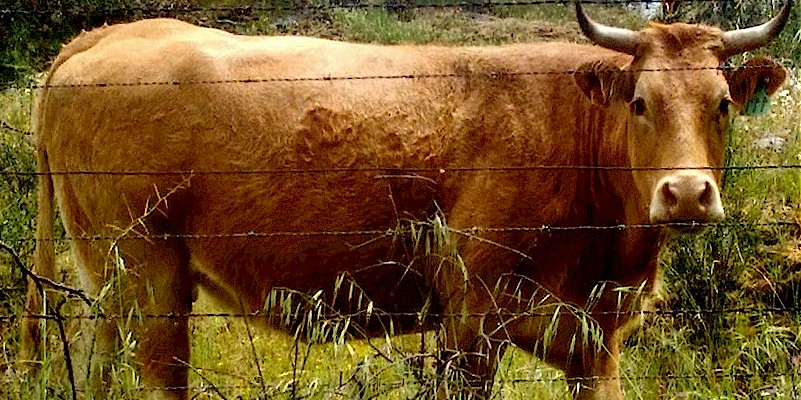 Alentejana cattle are energetic and gentle bovines from the Alentejo
region of Portugal. They are raised for meat production and as draft animals.
They are similar to the Retinta cattle breed found in Spain. Alentejana cattle
are golden red with long horns.
Alentejana cattle are energetic and gentle bovines from the Alentejo
region of Portugal. They are raised for meat production and as draft animals.
They are similar to the Retinta cattle breed found in Spain. Alentejana cattle
are golden red with long horns. Both the Mertolenga and Southern Crioulo cattle breeds from Brazil originated from the Alentejana cattle breed. Alentejana cattle have the protected geographical status of DOC (Denominação de Origem Controlada) from the European Commission | ||
 | ||
| ||
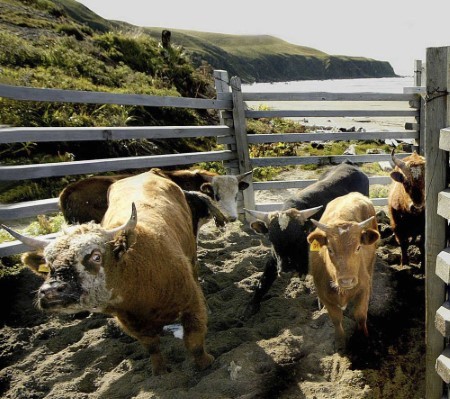 In the remote and untamed reaches of the Alaskan Aleutian islands, roams a breed of feral wild cattle as rugged and resilient as the landscapes they inhabit – the Aleutian wild cattle. Born from the rugged wilderness of the Aleutian archipelago, these majestic creatures embody the essence of untamed freedom, their very existence a testament to the raw power of nature.
In the remote and untamed reaches of the Alaskan Aleutian islands, roams a breed of feral wild cattle as rugged and resilient as the landscapes they inhabit – the Aleutian wild cattle. Born from the rugged wilderness of the Aleutian archipelago, these majestic creatures embody the essence of untamed freedom, their very existence a testament to the raw power of nature.For centuries, these elusive cattle have wandered the windswept shores and rocky cliffs of the Aleutian islands, forging a life amidst the harsh realities of their untamed habitat. With each passing year, their numbers have dwindled, their existence threatened by the encroachment of civilization and the relentless march of progress. Despite numerous attem ... | ||
 | ||
| ||
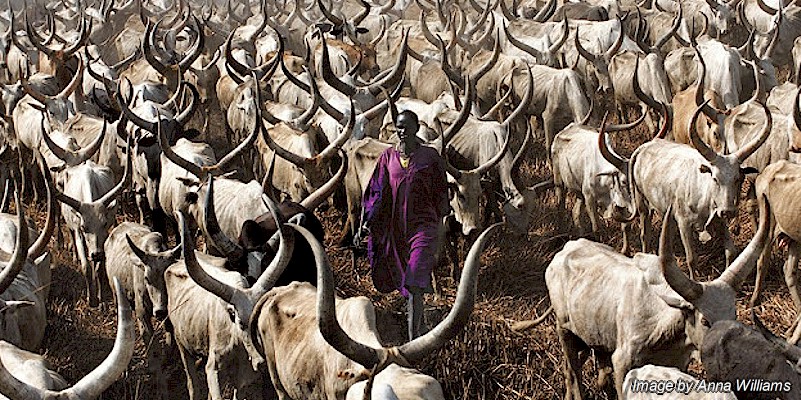 Aliab Dinka cattle, also known as Nilotic Sanga, represent a distinct variation of the Sanga cattle breed, specifically raised by the Aliab Dinka people of South Sudan. The Aliab Dinka people are a subgroup of the Dinka community and historically inhabited an area west of the upper White Nile River.
Aliab Dinka cattle, also known as Nilotic Sanga, represent a distinct variation of the Sanga cattle breed, specifically raised by the Aliab Dinka people of South Sudan. The Aliab Dinka people are a subgroup of the Dinka community and historically inhabited an area west of the upper White Nile River.Characterized by their large bodies, long horns, and small cervico-thoracic humps, Aliab Dinka cattle typically exhibit coats in shades of white, grey, or light fawn. The origin of the Sanga stock can be traced back to Ethiopia, with the Nilotic Sanga breed believed to have emerged from early migrations. They spread across south-western Ethiopia into Southern Sudan, adapting to local environmental conditions and evolving di ... | ||
 | ||
| ||
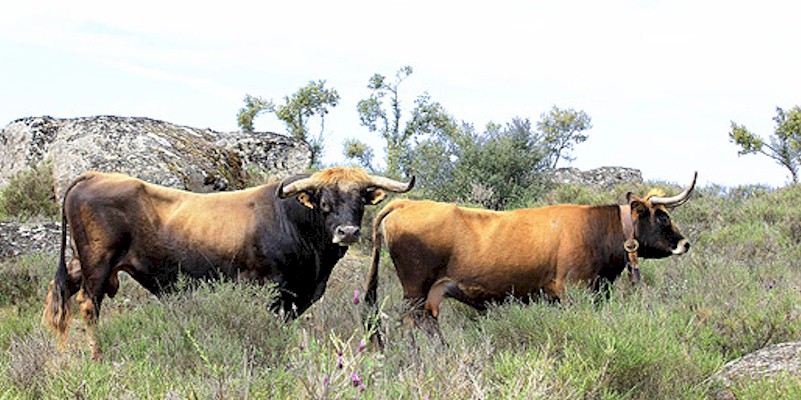 Alistana-Sanabresa cattle are a crossbreed of Alistana and
Sanabresa cattle. They produce high yields of good quality meat even on poor
pasture. They are housed and given fodder only under extreme environmental
conditions.
Alistana-Sanabresa cattle are a crossbreed of Alistana and
Sanabresa cattle. They produce high yields of good quality meat even on poor
pasture. They are housed and given fodder only under extreme environmental
conditions.Adult females are 131-142 cm high, weight 500-535 kg., and have a chestnut coat that darkens towards their front. Adult males are 145-155 cm high, weight 650-900 kg., and have a chestnut coat with the same pattern as females but darker. They are very hardy. While they tend to be less productive than more mainstream breeds, they adapt better to a wide range of environments (fewer sanitary problems, fewer calving difficulties, and they are better at utilizing local pastures). | ||
 | ||
| ||
 Allmogekor is a generic term for old native breeds of cattle
from Sweden. Including the following breeds:
·
Allmogekor is a generic term for old native breeds of cattle
from Sweden. Including the following breeds:
·
| ||
 | ||
| ||
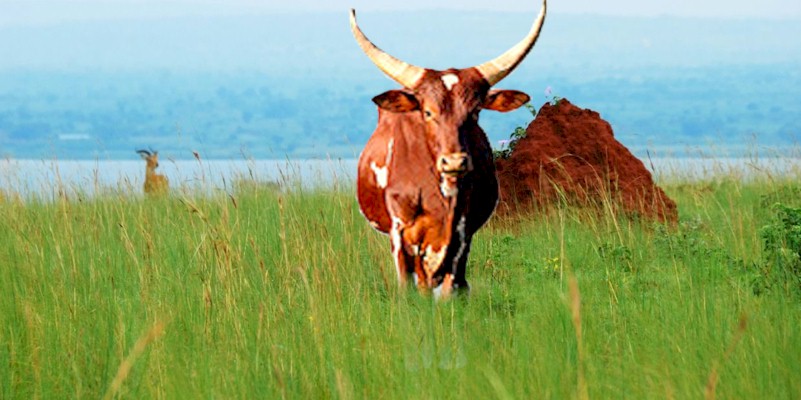
Alur Cattle (also known as Nioka or Blukwa) cattle are a
crossing of Ankole cattle with Lugware and Nkedi cattle (both Small East
African Zebu breeds). | ||
 | ||
| ||
 The American Beef Friesian is a breed of cattle that is a cross between the Holstein and Angus breeds. They are known for their high milk production and good meat quality. They have a black and white color pattern, with the black color coming from the Angus genetics. They are also known for their hardiness and adaptability to a variety of environments. They are typically raised for both milk and meat production.
The American Beef Friesian is a breed of cattle that is a cross between the Holstein and Angus breeds. They are known for their high milk production and good meat quality. They have a black and white color pattern, with the black color coming from the Angus genetics. They are also known for their hardiness and adaptability to a variety of environments. They are typically raised for both milk and meat production.
| ||
 | ||
| ||
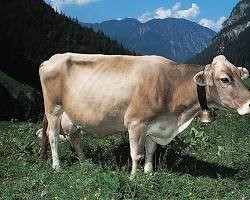 Hailing from the picturesque pastures of Switzerland, the American Brown Swiss stands as a paragon of dairy excellence, revered for its unrivaled milk production and esteemed status as one of the most efficient milk producers among dairy breeds. With a legacy steeped in centuries of Swiss husbandry, these magnificent creatures have garnered international acclaim for their exceptional qualities and versatile utility.
Hailing from the picturesque pastures of Switzerland, the American Brown Swiss stands as a paragon of dairy excellence, revered for its unrivaled milk production and esteemed status as one of the most efficient milk producers among dairy breeds. With a legacy steeped in centuries of Swiss husbandry, these magnificent creatures have garnered international acclaim for their exceptional qualities and versatile utility.Robust and commanding in stature, the American Brown Swiss cuts an imposing figure, its large frame and muscular build a testament to its genetic prowess. Adorned in a distinctive light brown coat with a striking white face, these majestic animals exude an air of timeless elegance, their regal presence commanding atte ... | ||
 | ||
| ||
 The American White Park is a rare breed of cattle that originated in Great Britain. They are known for their distinctive white color and long horns. They are large animals, with a docile temperament and are known for their hardiness and ability to adapt to different climates. They are typically raised for their meat, and are known to have good marbling, which gives their meat a good flavor and texture. They are also raised for their leather and bones. They have been used for breeding with other breeds to improve the meat quality. They are considered a rare breed and conservation efforts are being made to preserve the breed.
The American White Park is a rare breed of cattle that originated in Great Britain. They are known for their distinctive white color and long horns. They are large animals, with a docile temperament and are known for their hardiness and ability to adapt to different climates. They are typically raised for their meat, and are known to have good marbling, which gives their meat a good flavor and texture. They are also raised for their leather and bones. They have been used for breeding with other breeds to improve the meat quality. They are considered a rare breed and conservation efforts are being made to preserve the breed.
| ||
 | ||
| ||
 Amerifax is a breed of cattle that is a cross between the American Hereford and the American Charolais breeds. They are known for their high growth rate and good meat quality. They have a distinctive red and white color pattern, with the red color coming from the Hereford genetics and the white color coming from the Charolais genetics. They are also known for their hardiness and adaptability to a variety of environments. They are typically raised for both milk and meat production. They are known for their good carcass quality, feed efficiency and docile temperament. They are also used in crossbreeding programs to improve the growth rate, carcass quality and feed efficiency of other breeds.
Amerifax is a breed of cattle that is a cross between the American Hereford and the American Charolais breeds. They are known for their high growth rate and good meat quality. They have a distinctive red and white color pattern, with the red color coming from the Hereford genetics and the white color coming from the Charolais genetics. They are also known for their hardiness and adaptability to a variety of environments. They are typically raised for both milk and meat production. They are known for their good carcass quality, feed efficiency and docile temperament. They are also used in crossbreeding programs to improve the growth rate, carcass quality and feed efficiency of other breeds.
| ||
 | ||
| ||
 The Amiata cattle breed, originating from the rugged Amiata region of Italy, is renowned for its resilience, adaptability, and multifaceted utility. These medium-sized animals are prized for their hardiness and exceptional disease resistance, traits that have enabled them to thrive in the challenging terrain of mountainous regions.
The Amiata cattle breed, originating from the rugged Amiata region of Italy, is renowned for its resilience, adaptability, and multifaceted utility. These medium-sized animals are prized for their hardiness and exceptional disease resistance, traits that have enabled them to thrive in the challenging terrain of mountainous regions.
Sporting a distinctive dark brown coat and short horns, Amiata cattle are not only visually striking but also highly productive. Their high milk yield, particularly notable during the summer months, coupled with excellent milk quality, positions them as valuable contributors to dairy production. Furthermore, they serve as reliable sources of meat and are prized for their suitability as draught animals. ... | ||
 | ||
| ||
 The Amrit Mahal is a breed of cattle that originated in the Ka TAKA state of India. They are known for their hardiness and resistance to disease, as well as their ability to thrive in arid and semi-arid regions. They are medium to large animals, with a distinctive black color and long horns. They are known for their high milk production and good milk quality, with high butterfat and protein content. They are also used for draught purposes and as a source of meat. They are known for their hardiness and adaptability to different environments and are well suited to survive in hot and dry regions, which makes them well suited for the tropical climates of India. They are considered as a rare and endangered breed, conservation efforts are being m
...
The Amrit Mahal is a breed of cattle that originated in the Ka TAKA state of India. They are known for their hardiness and resistance to disease, as well as their ability to thrive in arid and semi-arid regions. They are medium to large animals, with a distinctive black color and long horns. They are known for their high milk production and good milk quality, with high butterfat and protein content. They are also used for draught purposes and as a source of meat. They are known for their hardiness and adaptability to different environments and are well suited to survive in hot and dry regions, which makes them well suited for the tropical climates of India. They are considered as a rare and endangered breed, conservation efforts are being m
...
| ||
 | ||
| ||
 Anatolian Black cattle are native to Turkey. They are known for their hardiness and resistance to disease, as well as their ability to thrive in harsh and semi-arid regions. They are medium to large animals, with a distinctive black or dark-brown color, and long horns. They are known for their high-milk production, especially during the summer months, and good milk quality. They are also used for drought purposes and as a source of meat. The breed is well suited to survive in hot and dry regions, which makes them well suited for the climate of Anatolia and the Mediterranean region. Due to their ability to survive in harsh conditions, they are considered as a hardy breed and well suited for extensive farming.
Anatolian Black cattle are native to Turkey. They are known for their hardiness and resistance to disease, as well as their ability to thrive in harsh and semi-arid regions. They are medium to large animals, with a distinctive black or dark-brown color, and long horns. They are known for their high-milk production, especially during the summer months, and good milk quality. They are also used for drought purposes and as a source of meat. The breed is well suited to survive in hot and dry regions, which makes them well suited for the climate of Anatolia and the Mediterranean region. Due to their ability to survive in harsh conditions, they are considered as a hardy breed and well suited for extensive farming.
| ||
 | ||
| ||
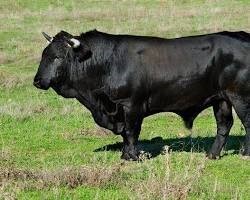 Originating from the sun-kissed landscapes of the Andalusia region in Spain, the Andalusian Black cattle, also known as "Castellana-Andaluza" or "Andalusian Grey", stand as a testament to the resilience and adaptability of livestock bred for the arid terrain. Revered for their hardiness and innate resistance to disease, these noble creatures are stalwart inhabitants of harsh and semi-arid regions, where they thrive amidst the rugged beauty of their native landscape.
Originating from the sun-kissed landscapes of the Andalusia region in Spain, the Andalusian Black cattle, also known as "Castellana-Andaluza" or "Andalusian Grey", stand as a testament to the resilience and adaptability of livestock bred for the arid terrain. Revered for their hardiness and innate resistance to disease, these noble creatures are stalwart inhabitants of harsh and semi-arid regions, where they thrive amidst the rugged beauty of their native landscape.Medium to large in size, with a distinctive gray hue that blends seamlessly with the arid hues of the Andalusian terrain, Andalusian Black cattle cut an impressive figure against the backdrop of their sun-drenched habitat. Adorned with long horns that speak to their h ... | ||
 | ||
| ||
 Originating from the serene landscapes of Angeln, Germany, Angeln Cattle have been meticulously cultivated and bred since the early 19th century, tracing their lineage back to 1830. Renowned for their exceptional milk production, these bovines are esteemed for their ability to yield milk with notably high butterfat content.
Originating from the serene landscapes of Angeln, Germany, Angeln Cattle have been meticulously cultivated and bred since the early 19th century, tracing their lineage back to 1830. Renowned for their exceptional milk production, these bovines are esteemed for their ability to yield milk with notably high butterfat content.
Bred with precision and purpose, the current breeding standard for Angeln Cattle aspires to achieve an impressive milk yield of 9,000 kilograms, boasting a butterfat content of 4.8% and a protein content of 3.8%. This meticulous breeding program reflects a commitment to excellence and underscores the breed''s reputation for premium dairy production. Fully mature Angeln cows typically stand between 1 ... | ||
 | ||
| ||
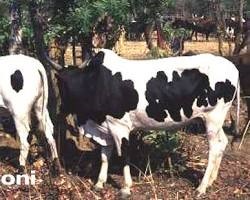 Hailing from the vibrant landscapes of Malawi in Africa, Angoni cattle emerge as a symbol of resilience and adaptability, embodying the indomitable spirit of livestock bred to thrive in the harshest of environments. Revered for their hardiness and innate resistance to disease, these magnificent creatures are stalwart inhabitants of harsh and semi-arid regions, where they navigate the rugged terrain with ease and grace.
Hailing from the vibrant landscapes of Malawi in Africa, Angoni cattle emerge as a symbol of resilience and adaptability, embodying the indomitable spirit of livestock bred to thrive in the harshest of environments. Revered for their hardiness and innate resistance to disease, these magnificent creatures are stalwart inhabitants of harsh and semi-arid regions, where they navigate the rugged terrain with ease and grace.Medium to large in stature, with a distinctive black or dark-brown coat that serves as a testament to their rugged heritage, Angoni cattle command attention with their imposing presence and robust build. Adorned with long, elegant horns that speak to their ancestral lineage, these majestic animals evoke a sense of ... | ||
 | ||
| ||
 Angus Beef, also known as Aberdeen cattle, are a very successful and well known breed of cattle. They originated in Scotland in the highlands of Northern Scotland, in the countries or "shires" of Angus and Aberdeen of Angus and Aberdeenshire, but today they are found worldwide as one of the most successful cattle ever. There are two strains in the Angus breed - Black and Red, and are naturally polled.
Angus Beef, also known as Aberdeen cattle, are a very successful and well known breed of cattle. They originated in Scotland in the highlands of Northern Scotland, in the countries or "shires" of Angus and Aberdeen of Angus and Aberdeenshire, but today they are found worldwide as one of the most successful cattle ever. There are two strains in the Angus breed - Black and Red, and are naturally polled.Angus cattle, locally also known as doddies or hummlies, were developed by three Scottish ranchers in the early 1800s. Hugh Watson. Both Hugh Watsons father and grandfather had been cattle buyers and breeders. The family is known to have owned cattle as early as 1735. Hugh Watson became a tenant of Keillor Farm in Angus in 1 ... | ||
 | ||
| ||
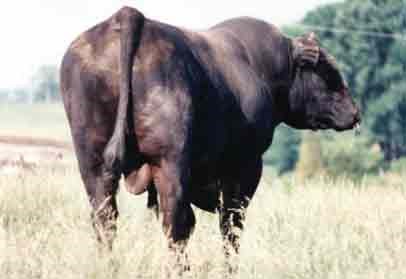 Angus Hybrid cattle are black polled composite cattle
developed from American Angus blended with enough Continental Breed genetics to
add lean red meat performance to the widely acknowledged Angus carcass quality
and maternal characteristics. Angus hybrids have been developed in a number of
different combinations using different continental carcass breed genetics to
achieve the desired carcass performance. True Angus hybrids are at least 5/8
American Angus and often have as much as 3/4 Angus blood. Data collected over
the past 10 years has suggested superior carcass performance can be expected
without sacrifice of the normal Angus genetic traits. Most Angus hybrids have
the performance data available and some strains have demonstra
...
Angus Hybrid cattle are black polled composite cattle
developed from American Angus blended with enough Continental Breed genetics to
add lean red meat performance to the widely acknowledged Angus carcass quality
and maternal characteristics. Angus hybrids have been developed in a number of
different combinations using different continental carcass breed genetics to
achieve the desired carcass performance. True Angus hybrids are at least 5/8
American Angus and often have as much as 3/4 Angus blood. Data collected over
the past 10 years has suggested superior carcass performance can be expected
without sacrifice of the normal Angus genetic traits. Most Angus hybrids have
the performance data available and some strains have demonstra
...
| ||
 | ||
| ||
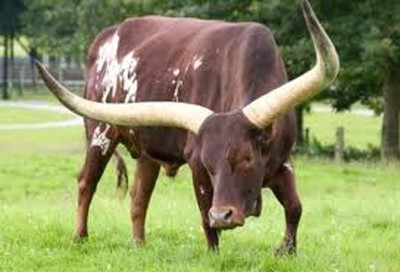 Ankole-Watusi, or just Ankole, cattle go back many hundreds
of years and their ancestry can be traced back to Europe and Asia as early as
15000 BC. Today Ankole cattle are distributed mostly from Lake Mobutu to Lake
Tanganyika in eastern Africa.
Ankole-Watusi, or just Ankole, cattle go back many hundreds
of years and their ancestry can be traced back to Europe and Asia as early as
15000 BC. Today Ankole cattle are distributed mostly from Lake Mobutu to Lake
Tanganyika in eastern Africa.
They are very hardy animals and can live in very poor conditions with little water and poor grazing. Ankole cattle have a medium-long head, a short neck with a deep dewlap and a narrow chest. Their horns are extremely long and grow outward on either side of the head. They also have fairly large ears through which they lose heat. Most often the coloration is red but fawn, black or pied are not uncommon. They are highly prized as status symbols, for ceremonial functions and n ... | ||
 | ||
| ||
 Aosta cattle is a breed of cattle that originated in the Aosta Valley region of Italy. They are known for their hardiness and resistance to disease, as well as their ability to thrive in harsh and mountainous regions. They are medium-sized animals, with a distinctive red or brown color, and short horns. They are known for their high milk production, especially during the summer months, and good milk quality. They are also used for drought purposes and as a source of meat. The breed is well-suited to survive in rugged and mountainous regions, which makes them well-suited for the climate of Aosta Valley. Due to their ability to survive in harsh conditions, they are considered as a hardy breed and well-suited for extensive farming. They are co
...
Aosta cattle is a breed of cattle that originated in the Aosta Valley region of Italy. They are known for their hardiness and resistance to disease, as well as their ability to thrive in harsh and mountainous regions. They are medium-sized animals, with a distinctive red or brown color, and short horns. They are known for their high milk production, especially during the summer months, and good milk quality. They are also used for drought purposes and as a source of meat. The breed is well-suited to survive in rugged and mountainous regions, which makes them well-suited for the climate of Aosta Valley. Due to their ability to survive in harsh conditions, they are considered as a hardy breed and well-suited for extensive farming. They are co
...
| ||
 | ||
| ||
 Apulian Podolian cattle is a breed of cattle that originated in the Apulia region of Italy, and it is also known as Podolica. They are known for their hardiness and resistance to disease, as well as their ability to thrive in harsh and semi-arid regions. They are medium to large animals, with a distinctive dark-brown color, and long horns. They are known for their high milk production, especially during the summer months, and good milk quality. They are also used for drought purposes and as a source of meat. The breed is well suited to survive in hot and dry regions, which makes them well suited for the climate of Apulia region. Due to their ability to survive in harsh conditions, they are considered as a hardy breed and well suited for ext
...
Apulian Podolian cattle is a breed of cattle that originated in the Apulia region of Italy, and it is also known as Podolica. They are known for their hardiness and resistance to disease, as well as their ability to thrive in harsh and semi-arid regions. They are medium to large animals, with a distinctive dark-brown color, and long horns. They are known for their high milk production, especially during the summer months, and good milk quality. They are also used for drought purposes and as a source of meat. The breed is well suited to survive in hot and dry regions, which makes them well suited for the climate of Apulia region. Due to their ability to survive in harsh conditions, they are considered as a hardy breed and well suited for ext
...
| ||
 | ||
| ||
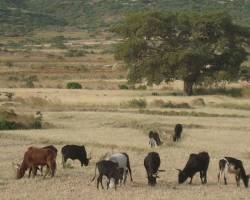 Arado cattle are from the North Ethiopian highlands. They are part of the Zenga breed group. Mainly they are bred as draught animals, particularly tillage. They fed mainly on crop residues. They are often cross-bred through bull and artificial insemination services.
Arado cattle are from the North Ethiopian highlands. They are part of the Zenga breed group. Mainly they are bred as draught animals, particularly tillage. They fed mainly on crop residues. They are often cross-bred through bull and artificial insemination services.
Arado cattle have red and black coats. Bulls and oxen have thick and short horns and a cervicothoracic hump; cows have medium, thin horns. Oxen weigh 254 kg and cows 201 kg on average. The average height at withers of 120 and 115 cm. Mating takes place on the grazing grounds, or the cow is brought to a bull in the neighborhood. Farmers try essentially to improve the Arado breed through crossbreeding with other indigenous breeds. This favors selection for fit ... | ||
 | ||
| ||
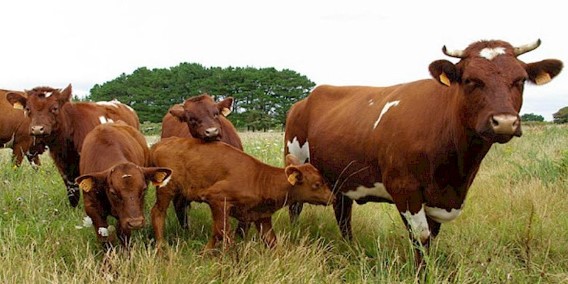 Armorican (known as French Armoricaine) are an endangered
French cattle raised for both milk and meat production. They were developed in
Brittany in the 19th century by cross-breeding local Froment du Léon and the
now-extinct Pie Rouge de Carhaix cattle with imported Shorthorn stock from the
United Kingdom.
Armorican (known as French Armoricaine) are an endangered
French cattle raised for both milk and meat production. They were developed in
Brittany in the 19th century by cross-breeding local Froment du Léon and the
now-extinct Pie Rouge de Carhaix cattle with imported Shorthorn stock from the
United Kingdom. Their name Armoricain came into use in 1923, and a herdbook was started in 1919. In the 1960s, the breed was used with Meuse-Rhine-Issel and Rotbunt stock, in the creation of the Pie Rouge des Plaines dairy cattle breed. Currently the breed is pretty rare, and in 2007 the Armorican cattle breed was listed by the FAO as “critically endangered”. Their total population was estimated at about 240 head in 2005, and was 26 ... | ||
 | ||
| ||
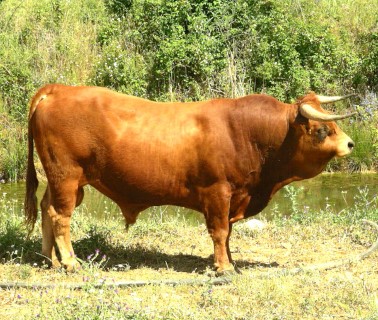 Arouquesa are relatively small cattle from Portugal. They
are raised for both milk and meat production. They are found almost exclusively
in the Northe ortuguese districts of Viseu, Braga, Aveiro and Porto. They
were granted protected geographical status of Denominacao de Origem Controlada
(DOC) from the European Commission.
Arouquesa are relatively small cattle from Portugal. They
are raised for both milk and meat production. They are found almost exclusively
in the Northe ortuguese districts of Viseu, Braga, Aveiro and Porto. They
were granted protected geographical status of Denominacao de Origem Controlada
(DOC) from the European Commission.
They are light brown; although the bulls may become a little
darker than the cows. Both bulls and cows have horns. Their horns are large
which are wide and are directed forward, first down and then up. They have
pretty strong legs, and their hind legs are very muscular. The bulls can reach
a height of about 134 cm, and the cows about 123 cm. Average live body weight
of the mature cows va
...
| ||
 | ||
| ||
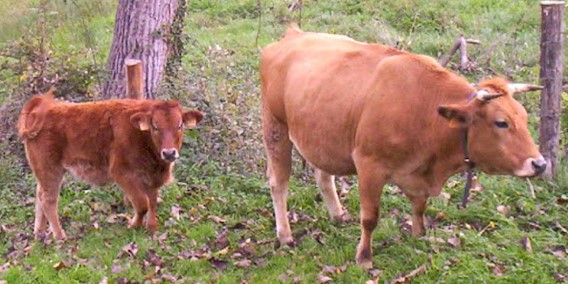 Asturian Valley (also known as Asturiana Occidental, sturiana de los Valles, and Carrenana) cattle are raised for both milk andrnmeat production. They originated in the valleys of Asturias, Spain and belongsrnto an exclusive bovine group in Spain known as the tronco Cantabrico (Cantabricrntrunk).
Asturian Valley (also known as Asturiana Occidental, sturiana de los Valles, and Carrenana) cattle are raised for both milk andrnmeat production. They originated in the valleys of Asturias, Spain and belongsrnto an exclusive bovine group in Spain known as the tronco Cantabrico (Cantabricrntrunk). They are mostly raised in the northern coastal areas on the ay of Biscay and the river valleys at the foot of the Cordillera Cantabricarnmountain range. Their importance as dairy cattle has reduced since otherrnhighly productive dairy cattle breeds have been introduced to Spain. They werernthe most abundant breed in the northern part of the country during the 19thrncentury. But a massive addition of highly productive foreign breed ... | ||
 | ||
| ||
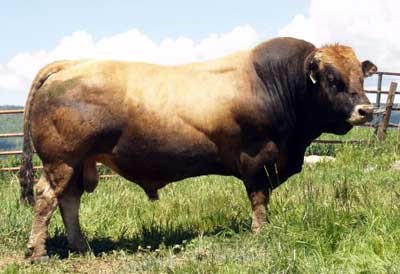 Aubrac are a moderate-framed, highly maternal breed from
southern France that were developed centuries ago for production of
forage-based beef.
Aubrac are a moderate-framed, highly maternal breed from
southern France that were developed centuries ago for production of
forage-based beef.
The Aubrac region supports little grain production, so economic reality has propelled selection for productive and efficient beef cattle. As the U.S. industry moves toward more moderate-framed, deeper-bodied and practical cattle, Aubrac cattle have caught the attention of many cattlemen. Developed in an all-forage environment in a remote area of southern France, the Aubrac breed has placed strong emphasis on cows that calve on a regular basis -- or they leave the herd. Maternal calving ease is exceptional. Cows have sound udders and optimal milk production for our major bee ... | ||
 | ||
| ||
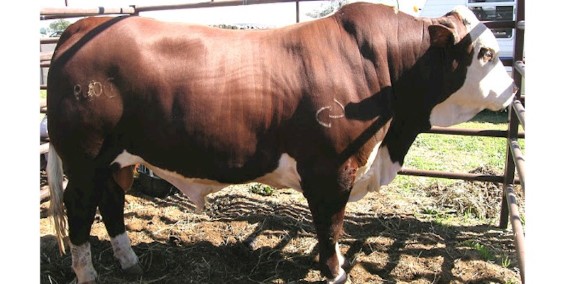 Australian Braford cattle are raised mainly for meat
production. As the name suggests, they are from Australia and developed in Queensland between 1946 and 1952. They were developed with the goal of producing cattle that were resistant to cattle ticks and tolerate heat better than some other cattle breeds. They were developed as a cross between a Hereford bull and a Brahman cow, and they carry the characteristics of both breeds. Currently they have stabilized at approximately 50 percent Brahman and 50 percent Hereford.
Australian Braford cattle are raised mainly for meat
production. As the name suggests, they are from Australia and developed in Queensland between 1946 and 1952. They were developed with the goal of producing cattle that were resistant to cattle ticks and tolerate heat better than some other cattle breeds. They were developed as a cross between a Hereford bull and a Brahman cow, and they carry the characteristics of both breeds. Currently they have stabilized at approximately 50 percent Brahman and 50 percent Hereford.
Australian Brafords are mainly found in NSW and Queensland. Semen of the breed has been exported to some countries especially to South Africa and South America. Live cattle exports have also been made in s ... | ||
 | ||
| ||
 Australian Lowline cattle are a group of specially bred
Angus cattle from Australia.
Australian Lowline cattle are a group of specially bred
Angus cattle from Australia.
In 1974, a special research project was commenced at the Trangie Research Centre in New South Wales utilizing the Angus herd of the prize-winning Trangie Stud; this had been a ‘closed’ herd (meaning, no new blood had been introduced) since 1964. The project involved breeding animals for size, selecting the largest and smallest animals respectively as comparative groups – with the remainder of the herd acting as a control. By 1992 a herd that bred true for small size and early maturity had been developed and an Association was formed to promote what was to be known as the Australian Lowline cattle. Although con ... | ||
 | ||
| ||
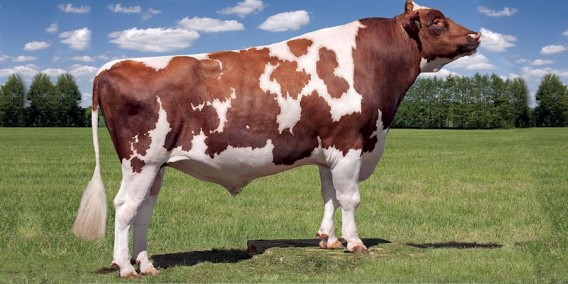 Ayrshire are dairy cattle that originated from Ayr county,
Scotland. They were developed from local cattle crossed with Shortgang, Tiswaters,
Alderney, Jersey, Dutch, Guernsey, and most significantly Dutch cattle.
Ayrshire are dairy cattle that originated from Ayr county,
Scotland. They were developed from local cattle crossed with Shortgang, Tiswaters,
Alderney, Jersey, Dutch, Guernsey, and most significantly Dutch cattle. They are successful in climates that cool, since they do not tolerate high temperatures. Their head slightly elongated in the front. Their neck is medium length, thin, with fine folds of skin, smoothly passes into the shoulder. Their chest is deep and moderately broad with a small bosom. They are relatively short (height at the withers is 124 - 125 cm). | ||
 |